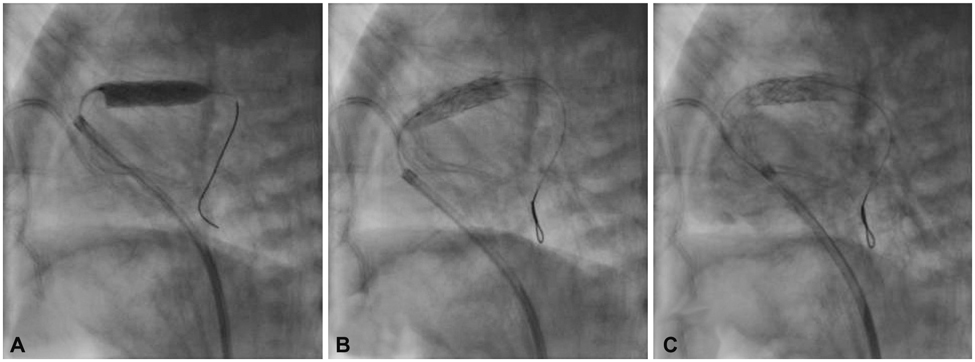Korean Circ J.
2011 Dec;41(12):744-746. 10.4070/kcj.2011.41.12.744.
Right Ventricular Outflow Tract Stenting in a Low Birth Weight Infant Born With Tetralogy of Fallot and Prostaglandin E1 Dependency
- Affiliations
-
- 1Department of Pediatrics, College of Medicine, University of Ulsan, Seoul, Korea. pediatrist@medimail.co.kr
- KMID: 1776250
- DOI: http://doi.org/10.4070/kcj.2011.41.12.744
Abstract
- Surgical skill and strategy for the correction of tetralogy of Fallot (TOF) have improved and resulted in satisfactory outcomes. However, prematurity and low birth weight continue to remain risk factors for poor outcomes. We present a case of a 2,150 g neonate born with TOF, in whom palliation was achieved with right ventricular outflow tract (RVOT) stenting. Seventy-seven days after the procedure, stenosis of RVOT below the stent was identified. At that time his body weight was 4.9 kg and total corrective surgery was deemed feasible. Eight months following surgical repair, the patient remained well without medical intervention. RVOT stenting may be a viable interim procedure while waiting for a low birth weight neonate born with TOF and prostaglandin E1 dependency to reach optimal weight to undergo corrective surgery.
MeSH Terms
Figure
Reference
-
1. Wernovsky G, Rubenstein SD, Spray TL. Cardiac surgery in the low-birth weight neonate: new approaches. Clin Perinatol. 2001. 28:249–264.2. Chang AC, Hanley FL, Lock JE, Castaneda AR, Wessel DL. Management and outcome of low birth weight neonates with congenital heart disease. J Pediatr. 1994. 124:461–466.3. Reddy VM, McElhinney DB, Sagrado T, Parry AJ, Teitel DF, Hanley FL. Results of 102 cases of complete repair of congenital heart defects in patients weighing 700 to 2500 grams. J Thorac Cardiovasc Surg. 1999. 117:324–331.4. Dohlen G, Chaturvedi RR, Benson LN, et al. Stenting of the right ventricular outflow tract in the symptomatic infant with tetralogy of Fallot. Heart. 2009. 95:142–147.5. Gibbs JL, Uzun O, Blackburn ME, Parsons JM, Dickinson DF. Right ventricular outflow stent implantation: an alternative to palliative surgical relief of infundibular pulmonary stenosis. Heart. 1997. 77:176–179.6. Laudito A, Bandisode VM, Lucas JF, Radtke WA, Adamson WT, Bradley SM. Right ventricular outflow tract stent as a bridge to surgery in a premature infant with tetralogy of Fallot. Ann Thorac Surg. 2006. 81:744–746.7. Jonas RA. Early primary repair of tetralogy of Fallot. Semin Thorac Cardiovasc Surg Pediatr Card Surg Annu. 2009. 39–47.8. Morales DL, Zafar F, Fraser CD Jr. Tetralogy of Fallot repair: the right ventricle infundibulum sparing (RVIS) strategy. Semin Thorac Cardiovasc Surg Pediatr Card Surg Annu. 2009. 12:54–58.9. Lee Y, Yang KM, Rho JR, Lee YK. Palliative surgery for tetralogy of Fallot: report of 43 cases. Korean Circ J. 1971. 1:17–21.10. Gladman G, McCrindle BW, Williams WG, Freedom RM, Benson LN. The modified blalock-taussig shunt: clinical impact and morbidity in Fallot's tetralogy in the current era. J Thorac Cardiovasc Surg. 1997. 114:25–30.11. Song JY, Yoo JJ, Noh JI, Choi JY, Yoon YS. Tentative results of balloon dilatation of the pulmonary valves. Korean Circ J. 2000. 30:745–750.12. Van Arsdell GS, Maharaj GS, Tom J, et al. What is the optimal age for repair of tetralogy of Fallot? Circulation. 2000. 102:19 Suppl 3. III123–III129.
- Full Text Links
- Actions
-
Cited
- CITED
-
- Close
- Share
- Similar articles
-
- Echocardiographic Findings in Tetralogy of Fallot
- The right ventricular outflow tract in tetralogy of Fallot by preoperative cardiac angiography
- Concomitant Right Ventricular Outflow Tract Cryoablation during Pulmonary Valve Replacement in a Patient with Tetralogy of Fallot
- A Case Report of Restrictive Ventricular Septal Defect & Left Ventricular Out Flow Tract Stenosis Caused by Fibrotic Tissue in Tetralogy of Fallot
- Pseudoaneurysm of Surgically Reconstructed Right Ventricular Outflow Tract Complicated by Superior Vena Cava Syndrome


